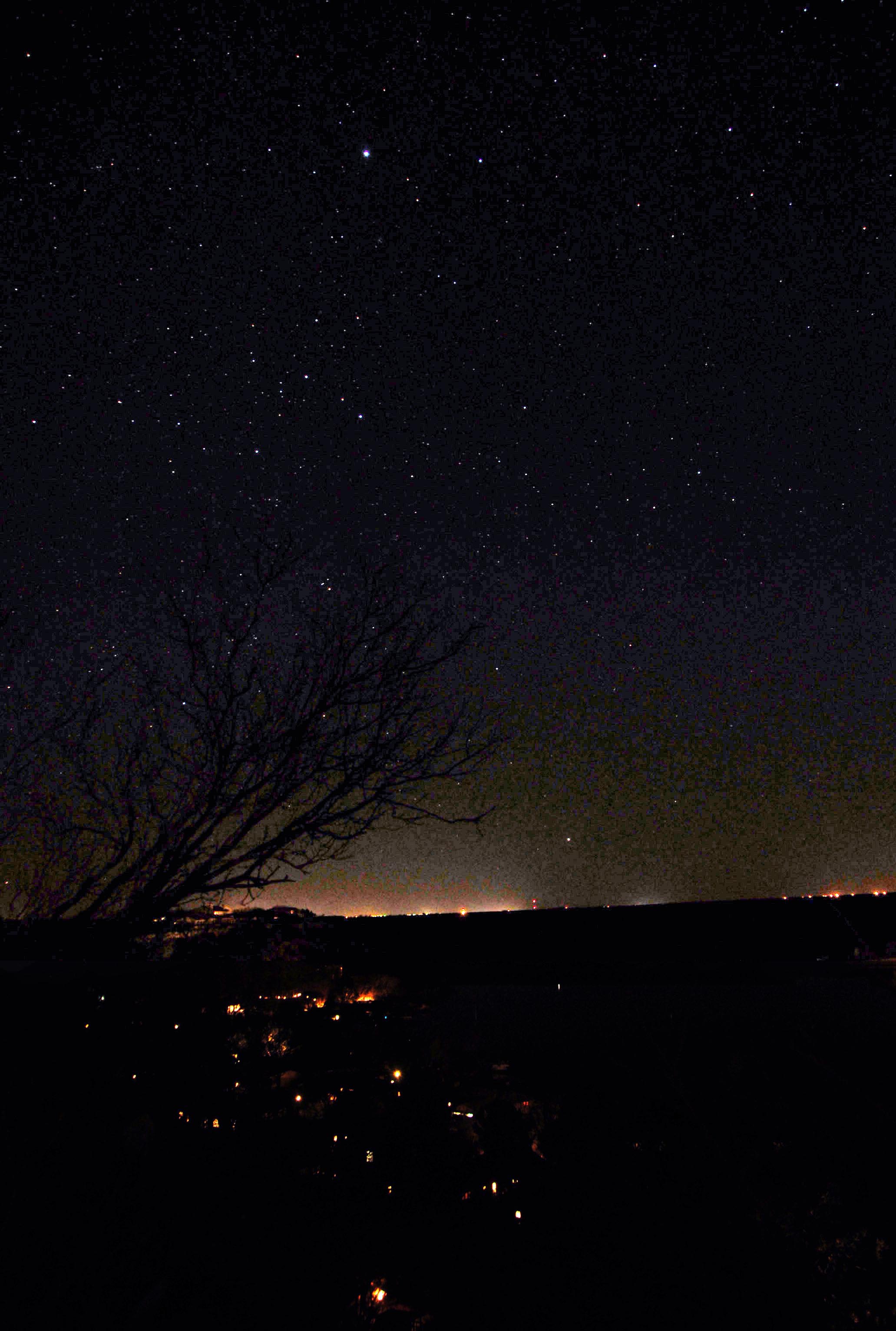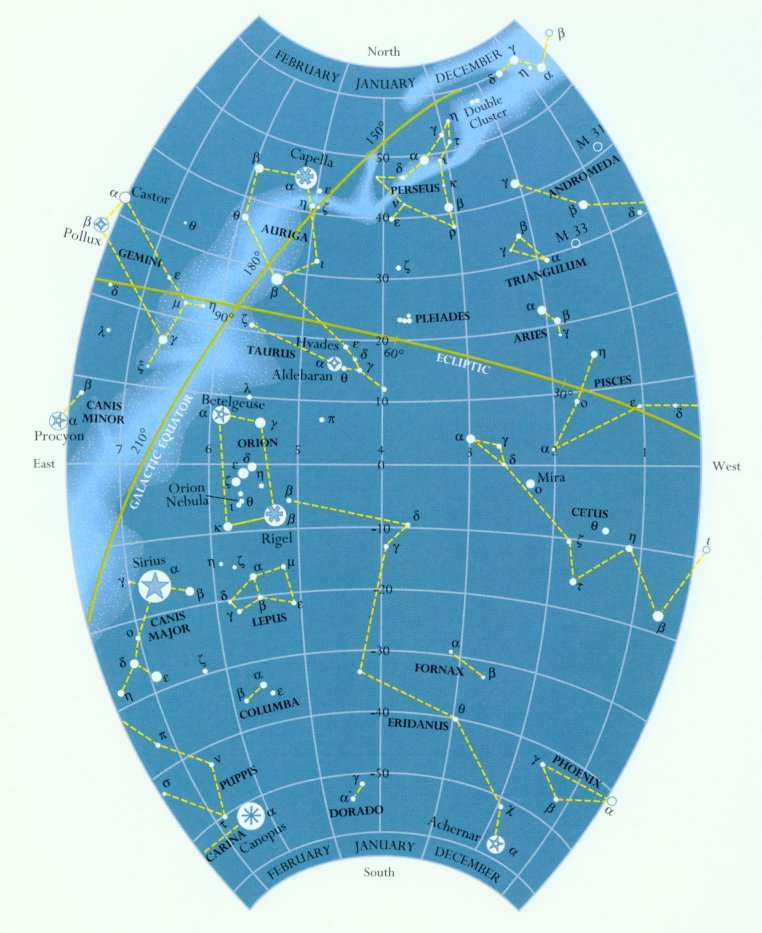
 | SOCO Blog |
10 February 2015
BRILLIANT VISITOR FROM THE SOUTH
Everyone is familiar with going outside at night this time of year and seeing Sirius shining brightly in the sky. It's hard to miss, since it's the brightest star we can see. However, most people who live in the southern part of the U.S. don't realize that, at this time of year, we can also see the second brightest star. That would be Canopus, which is part of the largely southern constellation of Carina. The photo below shows the view from the SOCO site at around 10 pm on the night of 7 February 2015, looking south. Sirius shines brightly near the top of the photo, while Canopus rides low on the horizon. The light dome on the horizon is from a nearby town. This is a 10-second exposure using a Nikon D300 camera with an 18-200 mm AF-S Nikkor lens, mounted on a tripod.

| 
|
As shown in the star map, Canopus is almost due south of Sirius in the sky. Canopus culminates (reaches its highest point in the sky) around 22 minutes before Sirius. At SOCO's location (latitude 33.5 deg N), Canopus is barely 4 degrees above the horizon at this point. Normally, a star this low on the horizon would be barely visible, since its light has to pass through the thickest part of the atmosphere and thus would be largely attenuated. It's only through its brilliance that Canopus makes itself known under these circumstances. Canopus has a visual magnitude of -0.62, compared to Sirius' visual magnitude of -1.44. In fact, Canopus and Sirius are the only two stars with negative visual magnitudes (visual magnitudes are expressed on a logarithmic scale). At a distance of only 8.6 LY, Sirius is one of our closest neighboring stars. Canopus is much farther away, at a distance of 307.7 LY. Were the two stars at comparable distances, Canopus would appear much brighter.
When I was in Junior High School in Temple, Texas, I did a lot of star watching. While Temple is at a latitude that should allow Canopus to be seen above the horizon, I don't remember ever seeing it. I think the reason is that the horizon around Temple has a lot more obstructions, particularly trees. Here on the Texas High Plains, we have unobstructed views of the horizon in all directions, so a low-elevation object like Canopus has a much better chance of being seen.
Canopus has a fascinating history. It was likely part of one of the oldest constellations, a constellation that emerged from the mists of our prehistoric past. The name Canopus is relatively recent if you consider ancient Greece as being "relatively recent." According to Richard H. Allen in his classic book "Star Names," the name is that of the chief pilot of the fleet of the Greek Menelaos that sailed to the Trojan War. Canopus is presently in the constellation Carina, which represents the keel of the ship Argo that the Greek Jason sailed in search of the Golden Fleece. But, as I said, these are fairly recent appellations. Going farther back in time, Allen describes that in Egypt this star was associated with the Nile River. Allen does not take this history farther back than Egypt, but we now know from archeological discoveries that the history of the star we now call Canopus goes back much farther.
The first hint of this comes from Egyptian star maps such as the Dendera Zodiac, which dates to around 36 BC. While artistically the constellations shown on this chart represent Egyptian figures, they actually are Egyptian versions of older Mesopotamian constellations. As described by John H. Rogers in his detailed review ("Origins of the Ancient Constellations: The Mesopotamian Traditions"), the earliest constellations were Mesopotamian. In the MULAPIN, a sort of Babylonian astronomical "textbook" written on clay tablets as early as 687 BC, our present Canopus is called NUNKI, which means the "Great Star of Eridu." Eridu was the most southerly of the great Mesopotamian cities, located at the point where the Euphrates River met the Persian Gulf. As described by Craig Crossen in his recent article in Sky & Telescope ("The Very Ancient Origins of the Water Constellations"), the city of Eridu dates back to as early as 4700 BC, and may be where the ancient Mesopotamian civilizations began. Eridu appears to have been abandoned around 3400 BC, as a result of the Euphrates abruptly changing its course. There are no written records of this, because the Mesopotamians didn't invent writing until around 3000 BC. However, we do have a constellation called Eridanus, and it does represent a river. The similarity between the names of the constellation (Eridanus) and the city (Eridu) is not likely a coincidence. The modern version of the constellation Eridanus is shown on the star map above. But, this version of Eridanus ends in the south at the bright star Achernar, not Canopus. However, as Crossen points out, there are some accounts that indicate the the ancient version of Eridanus ended at Canopus. This would then complete the ancient picture laid out long before the written word, that the constellation Eridanus represents the "River of Eridu" (the Euphrates) flowing south across the sky to its end at the "Great Star of Eridu" (now, Canopus).
When astronomers peer into the night sky, they are looking back in time. This is because the light we observe reaching us from most stars began its trip in the distant past. But it is also because the sky we observe with its patterns of stars is what the astronomers of Egypt, Babylon, and those before history looked upon in the distant past. This provides a connection between the modern and the ancient that we can experience on a clear dark night.
 Return to SOCO Blog Page
Return to SOCO Blog Page
 Return to SOCO Main Page
Return to SOCO Main Page
Questions or comments? Email SOCO@cat-star.org